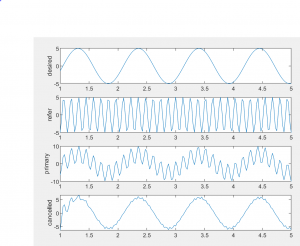Bobbie
Done this week
This week we received the parts for the test environment (minus the mannequin) and got the test environment set up and outputting. This required some research into getting IEC958 (S/PDIF) devices working with Ubuntu, but I got it after a little trial and error (images on next page).
In the images you can see that the speakers are quite close to each other. We might need some extension cables to get the speakers farther apart, but I think we should wait until we see if that’s a problem or not. Until we get the mic hardware set up, we can use the Matlab script I wrote last week to simulate sounds from this speaker setup.
Goals for next week
- Generate some test files using Matlab speaker geometry script (this should be very fast)
- Start working on signal processing side of things

Kevin
Done this week
This week we started by collecting speech files to test in a basic MATLAB simulation. We now have approximately 100 test files of different people speaking syllables/words/phrases that we can use for not only our MATLAB simulation but also our final hearing test. Additionally, we have started with our basic MATLAB simulations to narrow down the specific adaptive noise cancellation methods we will use. After attempting and tweaking multiple different variations of ANC, we decided to start with a simple Least-Means-Squared (LMS) ANC algorithm that would be both fast and simple to implement.
Below are two examples of our algorithm on two different test signals.


We found that this algorithm works much better when noise (reference) does not greatly affect desired signal (pretty obvious). Additionally, the two greatest factors in accuracy of our cancelled signal depended on both magnitude and period of the noise signal (ex. If reference signal has much smaller period than desired, you get cleaner cancelled signal).
Goals for next week
- Refine current ANC algorithm to handle more use cases
- Start considering how to implement ANC algorithm with multiple microphones
Sean
Done this Week
This week we received our surface-mount microphones. They are extremely small, so we need to create a PCB that will allow us to attach wires to it for testing. This week I designed a first draft of the board in Eagle with a premade solder footprint of the INMP621 microphone and attached it to screw-in wire pins. This will make it easy for us to try different wirings in the building phase. Eventually, I will design a similar PCB with solder pads so we can make the device smaller.
Goals for this Week
Sam said he could get me an Altium license, and I would like to try designing the PCB on there. With Eagle, I can’t rearrange the pins in the design, which is fine for the build testing phase, but may become a problem when we try to design a low-profile device.
I also would like to start programming on the Teensy board with the Arduino IDE. I will start out with simple audio input/output through the Teensy Audio Shield. I will also start researching libraries we can use to make audio processing easier and faster on the Teensy. Kevin and I will work together to implement an algorithm that is a good balance of effective and efficient. The LMS algorithm he is currently testing is fast, but may have some trouble working in our desired testing environment, a loud room, since the frequencies of the desired signal and the noise will be similar, since both will be human voices.
